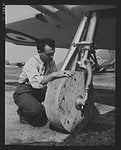GrauGeist
Generalfeldmarschall zur Luftschiff Abteilung
Ran across this photograph a while back, thought it was real interesting.
Aparently, they were using wheels made of wood to move the P-51s around the North American facility in Inglewood while the aircraft was being assembled.
When the aircraft was ready for tests, the regular wheels tires were installed.
This appears to be an early model P-51...
Aparently, they were using wheels made of wood to move the P-51s around the North American facility in Inglewood while the aircraft was being assembled.
When the aircraft was ready for tests, the regular wheels tires were installed.
This appears to be an early model P-51...


